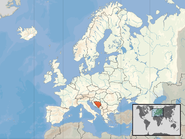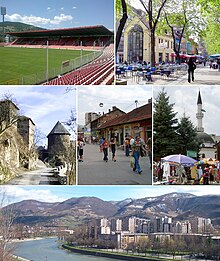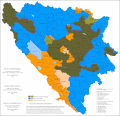Our website is made possible by displaying online advertisements to our visitors.
Please consider supporting us by disabling your ad blocker.
Portal:Bosnia and Herzegovina
Welcome to the Bosnia and Herzegovina Portal
 |
 |

| |
Bosnia and Herzegovina (Serbo-Croatian: Bosna i Hercegovina, Босна и Херцеговина), sometimes known as Bosnia-Herzegovina and informally as Bosnia, is a country in Southeast Europe, situated on the Balkan Peninsula. It borders Serbia to the east, Montenegro to the southeast, and Croatia to the north and southwest. In the south it has a 20-kilometre-long (12-mile) coast on the Adriatic Sea, with the town of Neum being its only access to the sea. Bosnia has a moderate continental climate with hot summers and cold, snowy winters. In the central and eastern regions, the geography is mountainous, in the northwest it is moderately hilly, and in the northeast it is predominantly flat. Herzegovina, the smaller, southern region, has a Mediterranean climate and is mostly mountainous. Sarajevo is the capital and the largest city.
The area has been inhabited since at least the Upper Paleolithic, but evidence suggests that during the Neolithic age, permanent human settlements were established, including those that belonged to the Butmir, Kakanj, and Vučedol cultures. After the arrival of the first Indo-Europeans, the area was populated by several Illyrian and Celtic civilizations. The ancestors of the South Slavic peoples that populate the area today arrived during the 6th through the 9th century. In the 12th century, the Banate of Bosnia was established; by the 14th century, this had evolved into the Kingdom of Bosnia. In the mid-15th century, it was annexed into the Ottoman Empire, under whose rule it remained until the late 19th century; the Ottomans brought Islam to the region. From the late 19th century until World War I, the country was annexed into the Austro-Hungarian monarchy. In the interwar period, Bosnia and Herzegovina was part of the Kingdom of Yugoslavia. After World War II, it was granted full republic status in the newly formed Socialist Federal Republic of Yugoslavia. In 1992, following the breakup of Yugoslavia, the republic proclaimed independence. This was followed by the Bosnian War, which lasted until late 1995 and ended with the signing of the Dayton Agreement.
The country is home to three main ethnic groups: Bosniaks are the largest group, Serbs the second-largest, and Croats the third-largest. Minorities include Jews, Roma, Albanians, Montenegrins, Ukrainians and Turks. Bosnia and Herzegovina has a bicameral legislature and a three-member presidency made up of one member from each of the three major ethnic groups. However, the central government's power is highly limited, as the country is largely decentralized. It comprises two autonomous entities—the Federation of Bosnia and Herzegovina and Republika Srpska—and a third unit, the Brčko District, which is condominium of both entities, but governed by its own local government.
Bosnia and Herzegovina is a developing country and ranks 74th in the 2018 Human Development Index. Its economy is dominated by industry and agriculture, followed by tourism and the service sector. Tourism has increased significantly in recent years. The country has a social-security and universal-healthcare system, and primary and secondary level education is free. It is a member of the United Nations, the Organization for Security and Co-operation in Europe, the Council of Europe, the Partnership for Peace, and the Central European Free Trade Agreement; it is also a founding member of the Union for the Mediterranean, established in July 2008. Bosnia and Herzegovina is an EU candidate country and has also been a candidate for NATO membership since April 2010. (Full article...)
Selected article -
Zenica (/ˈzɛnɪtsə/ ZEN-it-sə; Serbo-Croatian Cyrillic: Зеница; Serbo-Croatian pronunciation: [zěnitsa] ⓘ) is a city in Bosnia and Herzegovina and an administrative and economic center of the Federation of Bosnia and Herzegovina's Zenica-Doboj Canton. It is located in the Bosna river valley, about 70 km (43 mi) north of Sarajevo. The city is known for its Ironworks Zenica factory but also as a significant university center. According to the 2013 census, the settlement of Zenica itself counts 70,553 citizens and the administrative area 110,663, making it the nation's fourth-largest city.
The urban part of today's city was formed in several phases, including Neolithic, Illyrian, the Roman Municipium of Bistua Nuova (2nd–4th century; old name of the city), with an early Christian dual basilica. Traces of an ancient settlement have been found here as well; villa rustica, thermae, a temple, and other buildings were also present. Earliest findings in the place date from the period 3000–2000 BC; they were found in the localities of Drivuša and Gradišće. Zenica's current name was first mentioned in 1415. A medieval church has been unearthed in Zenica, as well as the Franciscan Monastery of St. Mary. The independence of Medieval Bosnia is directly connected to Zenica (Gradješa's plate and abjuration act; Kulin ban's time; Vranduk, a castle of the Bosnian kings; Janjići and 'hižas' [homes] of Bosnian Church members; stećci, stone tombstone monuments, etc.) During Ottoman rule (1463–1878), Zenica became a Muslim town; at the end of the 17th century, Zenica had 2,000 citizens, mostly Muslims; Orthodox and Catholic Christians are mentioned again from the end of the 18th century, and Jews in the 19th century. Modern Zenica was mostly built in the Austro-Hungarian and Yugoslavian periods. The population rose rapidly during the 20th century, and from the Bosnian War until 2013, the city lost a quarter of its population. The municipality of Zenica became the City of Zenica in 2014. (Full article...)
General images
More did you know
- ... that Iris Kadrić played international football for Sweden under-17s, before switching to play for Bosnia and Herzegovina?
Cities
- Banja Luka
- Bihać
- Berkovići
- Bijeljina
- Bosanska Krupa
- Bosanski Petrovac
- Brčko
- Brod
- Bugojno
- Cajnice
- Cazin
- Derventa
- Doboj
- Donji Vakuf
- Dubica
- Foča
- Goražde
- Gornji Vakuf
- Gračanica
- Gradačac
- Gradiška
- Ilidža
- Istočno Sarajevo
- Jajce
- Jablanica
- Kakanj
- Kalesija
- Konjic
- Kotor Varoš
- Laktaši
- Livno
- Ljubuški
- Lukavac
- Modriča
- Mostar
- Nevesinje
- Neum
- Novi Grad
- Novi Travnik
- Olovo
- Petrovo
- Prijedor
- Prnjavor
- Sanski Most
- Sarajevo
- Srebrenik
- Srebrenica
- Teslić
- Tešanj
- Travnik
- Trebinje
- Tuzla
- Velika Kladuša
- Visoko
- Vitez
- Zavidovići
- Zenica
- Zvornik
- Živinice
- Žepče
Selected biography -

Jezdimir Dangić (Serbian Cyrillic: Јездимир Дангић; 4 May 1897 – 22 August 1947) was a Yugoslav and Serb Chetnik commander during World War II. Born in the town of Bratunac, he was imprisoned during World War I for his membership of the revolutionary movement Young Bosnia. Dangić subsequently completed a law degree and became an officer in the gendarmerie of the Kingdom of Serbs, Croats and Slovenes at the beginning of 1928. In 1929, the country changed its name to the Kingdom of Yugoslavia. In 1940, Dangić was appointed to lead the court gendarmerie detachment stationed at the royal palace in the capital, Belgrade. During the Axis invasion of Yugoslavia in 1941, Dangić commanded the gendarmerie unit that escorted King Peter II to Montenegro as he fled the country. In August of that year, the leader of the Chetnik movement, Colonel Draža Mihailović, appointed Dangić as the commander of the Chetnik forces in eastern Bosnia. Here, Dangić and his men launched several attacks against the forces of the Independent State of Croatia (Serbo-Croatian: Nezavisna Država Hrvatska, NDH). Soon after his appointment, Dangić's Chetniks captured the town of Srebrenica from the occupiers. Afterwards, they became largely inactive in fighting the Germans, choosing instead to avoid confrontation. In December, Chetniks under Dangić's command massacred hundreds of Bosnian Muslims in the town of Goražde. In the same month, his Chetniks captured five nuns and took them with them through Romanija to Goražde, where they later committed suicide to avoid being raped.
In January 1942, Dangić ordered his forces to not resist German and NDH troops during the anti-Partisan offensive known as Operation Southeast Croatia. Afterwards, he was invited to Belgrade to negotiate the terms of proposed Chetnik collaboration with the Germans with the head of the collaborationist puppet government in the German-occupied territory of Serbia, Milan Nedić, and the Wehrmacht military commander of the territory, General der Artillerie Paul Bader. Although a deal was struck, it was vetoed by the Wehrmacht Commander in Southeast Europe, General der Pioniere Walter Kuntze, who remained suspicious of Dangić. Despite this, Dangić's Chetniks collaborated with German forces in eastern Bosnia over a period of several months beginning in December 1941. In April 1942, Dangić was arrested when he travelled to occupied Serbia despite promising to operate only within the territory of Bosnia, and was sent to a prisoner-of-war camp in German-occupied Poland. In 1943, he escaped from the camp and the following year participated in the Warsaw Uprising as a member of the Polish Home Army. In 1945, he was captured by the Soviet Red Army and was extradited to Yugoslavia, where he stood accused of committing war crimes. In 1947, he was tried, convicted, sentenced to death and executed by Yugoslavia's new communist authorities. (Full article...)
List of selected biographies
|
|---|
Did you know (auto-generated)

- ... that Ivan Ančić was the first Bosnian Franciscan to use the Latin script to write in his native language?
Subcategories
Related portals
Religions in Bosnia and Herzegovina
Ex-Yugoslav countries
Other countries
Topics
Recognized content
Things you can do

- Request images:
- Request maps:
- Sarajevo city location map
- Articles wanted:
- Clinical Center University of Sarajevo (Koševo hospital);
- Articles needing major work, Be Bold!: **
- Architecture of Bosnia and Herzegovina
- Health in Bosnia and Herzegovina
- Literature of Bosnia and Herzegovina
- List of universities in Bosnia and Herzegovina
- Foreign relations of Bosnia and Herzegovina
- Cinema of Bosnia and Herzegovina
- Subpages of List of settlements in the Federation of Bosnia and Herzegovina
- Stubs needing expansion:
- Featured Portals:
- Featured Pictures:
- Articles with Featured Article Candidate's status within reach:
- Current Featured Candidates:
- Featured Articles: (Don't be too bold!)
- Current Good Article Candidates:
- Good Articles:
- Former Good Articles:
Web resources
- B&H Tourism - Official Web Site
- Tourism Association of the Federation of Bosnia and Herzegovina - Official Web Site
- Tourism Association of Republika Srpska - Official Web Site
- Duga-Tehna
Other links:
- Bosnian National Monument - Muslibegovica House
- "Bosnia and Herzegovina". The World Factbook (2025 ed.). Central Intelligence Agency.
- Bosnia & Herzegovina Economy
- Bosnia and Herzegovina Map
- Bosnia News
- rjecnik.ba English-Bosnian and German-Bosnian On-line Dictionary (in Bosnian, English, and German)
- The State of Media Freedom in Bosnia and Herzegovina: The Public Service Broadcasting Report by the OSCE Representative on Freedom of the Media
Associated Wikimedia
The following Wikimedia Foundation sister projects provide more on this subject:
-
Commons
Free media repository -
Wikibooks
Free textbooks and manuals -
Wikidata
Free knowledge base -
Wikinews
Free-content news -
Wikiquote
Collection of quotations -
Wikisource
Free-content library -
Wikiversity
Free learning tools -
Wikivoyage
Free travel guide -
Wiktionary
Dictionary and thesaurus
Previous Page Next Page
بوابة:البوسنة والهرسك Arabic Portal:Bosna i Hercegovina BS Portál:Bosna a Hercegovina Czech Portal:Bosnien und Herzegowina German Portal:Bosnia y Herzegovina Spanish Portail:Bosnie-Herzégovine French Պորտալ:Բոսնիա և Հերցեգովինա HY Portale:Bosnia ed Erzegovina Italian Портал:Босния және Герцеговина KK Портал:Босна и Херцеговина MK





















































































